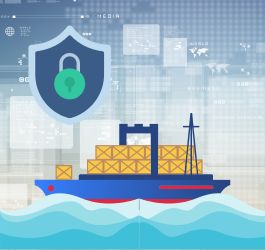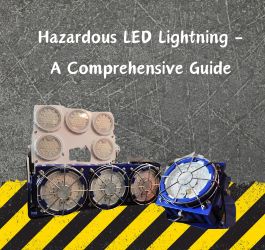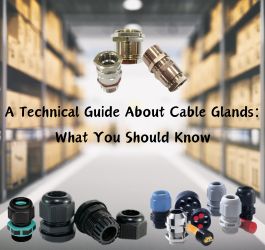In your maritime journeys, you've likely encountered various types of offshore cables and wires, sparking curiosity about their purpose and functionalities within the maritime realm.
This guide is crafted to provide you with comprehensive insights into offshore cables, unraveling their roles and significance in maritime settings. By the end of this exploration, you'll gain a deeper understanding of the essence and functions of these cables, enhancing your knowledge of their vital contributions.
Before delving into their myriad functions, let's first establish a clear definition of what offshore cables truly entail.Table Of Contents
What Is Offshore Cable?

Commonly known as oil & gas cables, offshore cables are meticulously engineered for applications in electrical power and instrumentation on offshore units. Acting as a crucial conduit, these cables serve as the lifeline for supplying electric power and facilitating instrumentation processes.
Given the challenging marine offshore environment, these cables must not only be durable but also robust to withstand the harsh conditions they encounter. Additionally, their design prioritizes the highest level of protection against fire and flame hazards.
Furthermore, offshore cables are adept at resisting mud and are halogen-free, providing resilience against drilling oils and hydrocarbons. Engineered to perform efficiently in extreme temperatures, they exhibit resistance to humidity, oil, acid, and saltwater corrosion.
The versatility of offshore cables extends to various platforms, including shipboard wiring, offshore platforms, and installations at sea for activities such as setting up oil rigs. Compliance with stringent safety standards is paramount, considering their operation in isolated environments with limited emergency accessibility.
To enhance safety, offshore cables are crafted to be halogen-free, ensuring they are non-toxic and secure in case of emergencies, given the challenges of accessing offshore facilities promptly.
This meticulous approach to design and safety standards underscores the vital role that offshore cables play in ensuring reliable power and instrumentation in the demanding offshore environment.
Setting the Bar: Offshore Cable Standards

Ensuring the quality of offshore cables is a meticulous process governed by specific standards that manufacturers must adhere to. Among these standards, two prominent ones play a pivotal role:
NEK 606
NEK 606, a Norwegian standard or technical specification (TS), is tailored for applications in the marine industry, encompassing offshore oil & gas drilling, ships, ship manufacturing, and other sectors utilizing instrumental, power, or earth cables.
NEK 606 standards are designed to guarantee that offshore cables exhibit mud resistance, are halogen-free, and possess fire-resistant or flame-retardant properties. In addition, these standards mandate SHF2-rated sheathing, combining thermosetting halogen-free characteristics with mud resistance.
IEEE 1580 Type P
The demanding and harsh conditions that offshore cables endure necessitate adherence to the IEEE 1580 standard. Defined by the Institute of Electrical and Electronics Engineers (IEEE), this standard focuses on the installation of offshore cables.
IEEE 1580 ensures that manufacturers follow the best engineering practices and adhere to a strict set of regulations during the cable production process. This meticulous approach aims to enhance the durability and strength of offshore cables, enabling them to withstand the challenging environments they operate in.
By upholding these standards, manufacturers contribute to the overall reliability and performance of offshore cables, ensuring they meet the stringent requirements of marine and offshore applications.
Types Of Offshore Cable
| Power Cable | RFOU, BFOU, TFOU, RFCU, RU, BU |
| VFD Cable | RFOU-VFD, RFOU-VFD, BFOU-VFD |
| Instrumentation Cable | RFOU(i), RFOU(c), RFOU(i&c), BFOU(i), BFOU(c), BFOU(i&c) |
| Earth Cable | P15 UX |
Code meaning here is the code used for different materials used in offshore cables:
| B | Halogen-free fire-resistant tape insulation around the conductor |
| R | Halogen-free Ethylene Propylene Rubber (EPR) |
| T | Cross-linked Polyethylene (XLPE) |
| U | Halogen-free thermostat compound EVA or EMA |
| F | Halogen-free inner covering |
| X | No armor used |
| O | Tinned copper wire braid for armor |
| C | Galvanized steel wire braid |
| U | Halogen-free thermoset compound SHF 2 or mud-resistant thermoset compound SHF Mud for outer sheath |
| (i) | Individual screen |
| (c) | Collective screen |
What Is The Difference Between RFOU And BFOU?

In the realm of offshore power cables, RFOU and BFOU stand out as versatile options suitable for various marine applications, including oil rigs, offshore platforms, and drilling rigs.
Both RFOU and BFOU cables share the distinction of being halogen-free, a critical feature ensuring safety and eliminating toxicity. It's crucial to note that offshore facilities and ships operate in isolated environments, where immediate assistance may not be readily available.
The stringent safety and fire standards that govern offshore power cables underscore their significance. Additionally, their resistance to mud enhances their suitability for demanding conditions prevalent in oil rig facilities, where power cables face some of the harshest challenges.
As guardians of seamless power supply in the marine environment, RFOU and BFOU cables emerge as reliable choices, marrying safety with resilience to meet the unique demands of offshore applications.
| RFOU | BFOU |
| Flame retardant cable | Fire-resistant cable |
| Chemically processed to resist fire, to burn slow, and is self-extinguishing | Made of nonflammable materials. Does not melt or drip when exposed to fire |
| Meets the IEC 60032-3-22 standard | Meets the IEC 60331 standard |
Offshore Cable Certification
Several classification societies globally provide certificates based on the quality of offshore cables, indicating that higher certifications correspond to better standards. These certifications play a crucial role in helping users choose offshore cables of the highest quality. Here are some key certifications:
ABS (American Bureau of Shipping)

- ABS offers certification, requiring manufacturers to undergo assessments such as Product Design Assessment (PDA) and Manufacturing Assessment (MA).
- Type Approval certifications are granted based on specific rules and standards set by ABS for offshore cables.
- Audits and compliance checks occur throughout the manufacturing process to ensure the product meets industry quality standards, covering both material quality and manufacturing processes.
DNV-GL (Det Norske Veritas-Germanischer Lloyd)

- DNV-GL, a leading European certification and classification entity formed in 2013 through the merger of Germanischer Lloyd (GL) and Det Norske Veritas (DNV).
- Initially focused on certifying offshore cables, DNV-GL expanded its scope to include marine cables and the oil and gas industry.
- Certification from DNV-GL signifies compliance with European quality standards, requiring offshore cables to meet criteria set by both Norwegian and German entities.
- Verification processes involve various tests, including joint witnessing, manufacturing witnessing, QA and QC process verification, and technical design verification.
Some other types of approval certificates include Bureau Veritas, Lloyd’s Register, NIPPON KAIJI KYOKAI, Korean Register, China Classification Society, and Registro Italiano Navale.
Offshore Cable Product Range
A diverse range of offshore cables is available, and we've examined a selection for your consideration.
 | Offshore power cableEngineered for power transmission on offshore units, the offshore power cable encompasses high voltage, medium voltage, and low voltage variants. Among the cable types are BFOU, RFOU, RU, BU, RFCU, BFCU, and TFOU, all characterized by their halogen-free, low smoke, and flame retardant properties. Additionally, there are options for fire-resistant or mud-resistant cables to suit specific environmental conditions. |
 | VFD cableDesigned for fixed installations on offshore units, the VFD cable is specifically tailored for Variable Frequency Drive (VFD) power applications. Noteworthy for its exceptional electromagnetic compatibility, this cable boasts a high-density shield and a compound shield design, effectively countering electromagnetic interference. Two notable variations include the flame-retardant RFOU-VFD cable type and the fire-resistant BFOU-VFD cable type. |
 | Instrumentation cableCrafted in compliance with NEK 606 and IEC 60092-376 standards, the offshore instrumentation cable serves the crucial role of facilitating telecommunication and instrumentation on offshore units and oil rig platforms. Notable features include low smoke (IEC 61034), halogen-free (IEC 60754), flame retardant (IEC 60332-3), fire-resistant (IEC 60331), and specialized mud resistance for specific applications. |
 | Earth cableCrafted in accordance with the NEK 606 and IEC 60092-353 standards, the Earth Cable P15 UX boasts a voltage rating of 0.6/1kV and a maximum operating temperature of 90℃. This cable finds application in earthing wire, bonding wire, and single wire setups on offshore units and fixed installations. Comprising a tinned copper wire conductor with polyolefin SHF2 insulation, the P15 UX stands out with its flame retardant, low smoke, and halogen-free characteristics. |
Offshore Cable Features

Numerous features contribute to the high-quality standards of offshore cables, aligning with international regulations and ensuring durability and efficiency.
The 5 key characteristics that define a reliable offshore cable include:
Flame retardant
- Conforming to standards such as IEC 60332-1 & IEC 60332-3-22, the offshore cable undergoes tests for flame-retardant properties.
- This characteristic ensures that the cable does not propagate fire, contributing to safety in ship vessels and offshore installations.
- The cable is designed with a coat of fire-resistant chemicals, slowing down the burning process in case of exposure to fire.
Zero halogen
- A halogen-free composition eliminates elements like chlorine, fluorine, bromine, iodine, and astatine from the offshore cable.
- Halogen-free cables are more protective in extreme environments, enhancing overall durability.
- Materials such as XLPE (Cross-linked polyethylene) and EPR (Ethylene propylene rubber) replace halogen-containing elements, reducing the risk of poisonous gas emission.
Low smoke
- Adhering to the IEC 61034-1, 2 standard, offshore cables are tested for low smoke emission, crucial for the safety of individuals in case of a fire.
- The cables should not produce excessive smoke, mitigating risks and ensuring the well-being of those on ships and offshore installations.
Fire resistant
- Complying with the IEC 60331 standard, this test evaluates the cable's resistance to fire, using a temperature of 830°C to simulate extreme conditions.
- The use of inflammable materials in the construction of offshore cables ensures they remain intact under high temperatures, resisting melting and preventing the spread of fire.
Mud resistant
- Special chemicals are incorporated into the coating of offshore cables to make them mud-resistant.
- This feature addresses the corrosive effects of exposure to mud, saltwater, acid, and oil, enhancing the cables' suitability for installation and operation in challenging conditions.
- Sheathing compounds contribute to the overall resilience of the cables, protecting them from adverse environmental factors.
In summary, a superior offshore cable encompasses these features to ensure optimal performance, safety, and longevity in demanding maritime and offshore environments.
Offshore Cables Functions
Let's be straightforward; the effectiveness and reliability of any application relying on offshore cables hinge on their ability to withstand the harsh marine environment.
Unlike ordinary cables that you might replace periodically, offshore cables are not interchangeable with alternatives like automotive cables, as the consequences could be detrimental.
Using offshore cables for their intended purposes is crucial to mitigate the risks of corrosion and other factors that may compromise efficiency and reliability.
In essence, offshore cables serve various functions, including:
- Offshore cables utilized in instrumentation
- Power cables tailored for offshore platforms
- Control systems integral to marine setups
- Communication systems crucial for offshore configurations
- Transmission systems operating within offshore environments
Offshore cables utilized in instrumentation
In the offshore marine environment, especially at docking points, a variety of devices are employed for diverse functions. It's essential to note that many machineries in offshore areas are large-scale and automated.
To meet the required parameters accurately, it is crucial to ensure proper control of these instruments. In most instances, this is where offshore cables come into play, facilitating the seamless functioning of all instrumentation processes.
However, there's a catch: for effective instrumentation in the offshore setting, it becomes imperative to choose specific types of offshore cables. Often, you'll observe that cables designed for such functions come with distinct properties, which we will delve into later in this guide.
Power cables tailored for offshore platform
It constitutes another vital function of an offshore cable. In reality, the diverse roles of various types of offshore cables often revolve around the distribution of power in various capacities.
Here's the essence: in offshore environments, power is indispensable for the operation and mobility of diverse machinery. Simultaneously, it plays a crucial role in energizing various components within the offshore setting to optimize efficiency.
Given the pivotal role of power in numerous functions, its transmission and distribution become imperative. All these functions seamlessly come to fruition by employing specialized offshore power cables.
Control systems integral to marine setups
Automation is integral to the design of various functions within offshore platforms. To optimize and sustain the performance of these automated systems, the presence of specific cables is crucial. Enter control cables — a vital component ensuring the seamless relay of commands to diverse functions, enhancing overall process efficiency.
These cables play a pivotal role in not only increasing efficiency but also accelerating specific processes within the dynamic environment of offshore platforms.
Communication systems crucial for offshore configurations
Communication stands as a crucial element within any offshore marine platform. Understanding the coordination of commands, processes, and functions is essential for optimizing overall efficiency. In the challenging offshore environment, relying solely on verbal communication is often impractical.
Instead, the use of communication gadgets and related equipment becomes imperative to effectively relay information to counterparts. This necessitates the procurement of high-quality offshore communication cables, ensuring optimal results in the communication process.
Transmission systems operating within offshore environments
Transmission within the marine system stands as a fundamental aspect that determines various processes. In the absence of offshore transmission cables, carrying out any meaningful function would be challenging.
Within the offshore environment, numerous machines and devices rely on a transmission system to deliver significant results. Ensuring the selection of the right cable is essential for achieving optimal outcomes in any offshore transmission system.
From the outlined descriptions, it is evident that offshore cables serve as integral components in fulfilling these core functions. These functions are not only vital for individual devices but are imperative for the seamless operation of any offshore platform.
Therefore, the selection and utilization of these cables become crucial for enhancing overall execution within the offshore setting.
Conclusion
As we conclude this guide, I trust that the insights you've gained have been valuable. Now equipped with knowledge about various facets of offshore marine cables, you are better prepared, particularly when considering a purchase. Explore our store to acquire top-quality offshore cables today!










